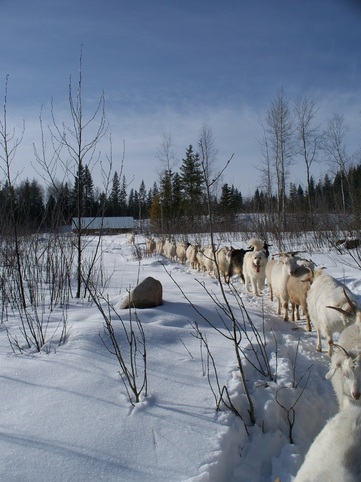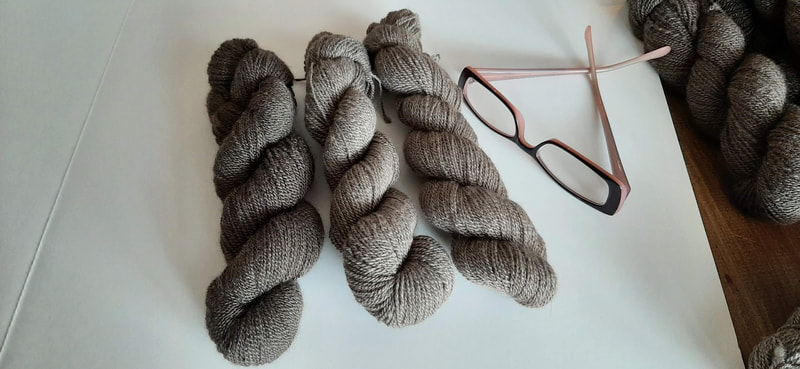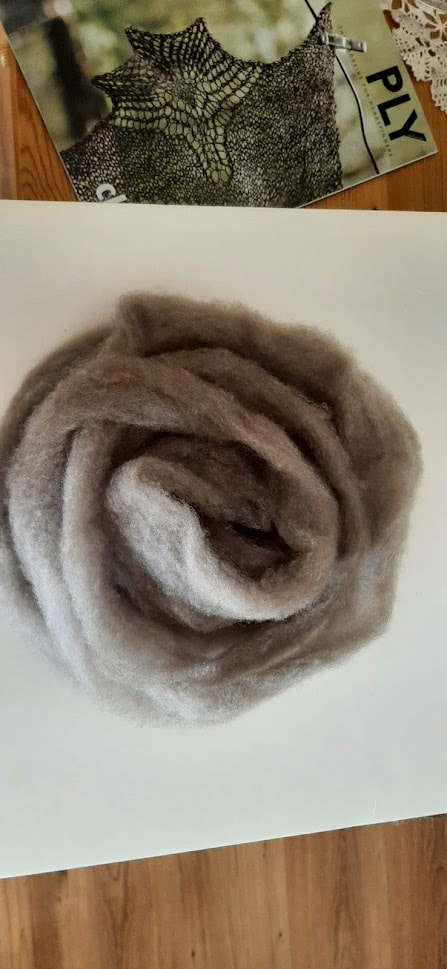CASHMERE
All the cashmere we offer is 100% Canadian, from healthy, happy cashmere goats on our farm.
cashmere yarn
Cashmere Roving
cashmere cloud

- Ivory
raw cashmere fleeces

- gently combed off the goats in early Spring
- white, ivory, and grey/grey brown sold whole (3 to 8 ounces)
- $18 per ounce or $0.64 per gram
Some of the things people have done with Canadian Cashmere
Cashmere Goats
In 2021, Harmony Farm discontinued the cashmere-goat breeding program.
Proof is in Performance
Cashmere Goats at Harmony Farm

The Central Cariboo Region is particularly well-suited to cashmere-goat farming. Our winters are cold; -30 degrees Celcius is not unusual, and we enjoy relatively dry, warm summers. Cashmere, the under down, grows from approximately the summer solstice until the winter solstice (June 21st to December 21st in the Northern Hemisphere), and our goats thrive here, protected by their luxurious cashmere and a bit of shelter, provided by us, from the prevailing winds and precipitation.
What do our Cashmere goats eat? Well, we have found that they are always crazy about willow and poplar bark. They are very choosey foragers - no, they don't eat your long johns off the clothesline, though they might take a little nibble to find out what that flappy thing is, anyways! And, Miss Itty Bitty Kitty, the farm's Peace Ambassador did suffer an inquisitive nibble of her stumpy tail, but that's another matter altogether.
In winter, we provide the goats with an all-they-can-eat, good-quality hay bar, supplemented with free-choice trace minerals and salt. Nevertheless, their favorite snack in the dead of winter seems to be Christmas Trees, in whatever shape or form we offer it to them. Last winter, a huge spruce broke off at half mast out in the Back 40, and the herd filed out every day, to browse on the needles, regardless of the weather.
In Springtime, before the leaves pop on the trees and before there is anything green anywere else, the goats relish the buds of cottonwoods. Maybe their collective memory knows something about Mother Nature's healthful gifts that we haven't been able to emulate or process.
Here's an interesting little fact. You know those pesky Ox Eye daisies (Chrysanthemum leucanthemum) that farmers are trying to eradicate from their hayfields? Well, our goats take a daisy here, then a mouthful of something else, and yet another daisy there..... as they browse along. Chrysanthemums are the source of pyrethrum, a natural source of insecticide.
View a local news report by Channel 10
about a visit to our farm, by clicking here.
What do our Cashmere goats eat? Well, we have found that they are always crazy about willow and poplar bark. They are very choosey foragers - no, they don't eat your long johns off the clothesline, though they might take a little nibble to find out what that flappy thing is, anyways! And, Miss Itty Bitty Kitty, the farm's Peace Ambassador did suffer an inquisitive nibble of her stumpy tail, but that's another matter altogether.
In winter, we provide the goats with an all-they-can-eat, good-quality hay bar, supplemented with free-choice trace minerals and salt. Nevertheless, their favorite snack in the dead of winter seems to be Christmas Trees, in whatever shape or form we offer it to them. Last winter, a huge spruce broke off at half mast out in the Back 40, and the herd filed out every day, to browse on the needles, regardless of the weather.
In Springtime, before the leaves pop on the trees and before there is anything green anywere else, the goats relish the buds of cottonwoods. Maybe their collective memory knows something about Mother Nature's healthful gifts that we haven't been able to emulate or process.
Here's an interesting little fact. You know those pesky Ox Eye daisies (Chrysanthemum leucanthemum) that farmers are trying to eradicate from their hayfields? Well, our goats take a daisy here, then a mouthful of something else, and yet another daisy there..... as they browse along. Chrysanthemums are the source of pyrethrum, a natural source of insecticide.
View a local news report by Channel 10
about a visit to our farm, by clicking here.
Cashmere
So, what about cashmere? Most of us don't just naturally associate that fine fibre with the goat, yet this is exactly where cashmere comes from.
Goats tend to have a layer of guard fibre and a type of soft underdown. That fine underdown is Cashmere. All goat breeds, except the Angora goat which has its own very special mohair fibre, produce varying quantity and quality of this fine underdown, and in fact, the goats that produce the best cashmere aren't officially a breed at all - they are a type.
Goats tend to have a layer of guard fibre and a type of soft underdown. That fine underdown is Cashmere. All goat breeds, except the Angora goat which has its own very special mohair fibre, produce varying quantity and quality of this fine underdown, and in fact, the goats that produce the best cashmere aren't officially a breed at all - they are a type.
Cashmere Classification

at Fibre Week 2010, we had the pleasure to participate in a cashmere classification workshop with Dr. Joe David Ross of Sonora Texas. The Canadian Cashmere Producers Association has produced a DVD and Tactile Workbook with samples of the cashmere fleeces evaluated, as a resource for cashmere enthusiasts. check it here
Combing Cashmere
We harvest the cashmere from our goats by combing them with a dog-groomer's shedding brush in late winter early spring when the cashmere begins to shed from the goats. It's similar to a spa treatment: they get a skin massage, have their 'hair' done, are treated to a pedicure, and there's a yummy food treat.
Curious to see how cashmere is combed from a goat? Take a look at the video below. This is Part 2 of a 3-part demonstration series produced by Diane Thompson of Riversong Farm and the Canadian Cashmere Producers Association. For Parts 1, 2 and 3, click here for a link to the YouTube videos.
Curious to see how cashmere is combed from a goat? Take a look at the video below. This is Part 2 of a 3-part demonstration series produced by Diane Thompson of Riversong Farm and the Canadian Cashmere Producers Association. For Parts 1, 2 and 3, click here for a link to the YouTube videos.















